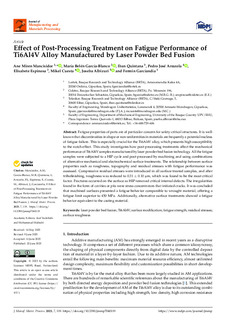Título
Effect of Post-Processing Treatment on Fatigue Performance of Ti6Al4V Alloy Manufactured by Laser Powder Bed FusionAutor-a (de otra institución)
Otras instituciones
IK4-LortekCentro de Tecnologías Electroquímcas (CIDETEC)
Universidad del País Vasco/Euskal Herriko Unibertsitatea (UPV/EHU)
Versión
Postprint
Derechos
© 2023 by the authors. Licensee MDPIAcceso
Acceso abiertoVersión del editor
https://doi.org/10.3390/jmmp7040119Publicado en
Journal of Manufacturing and Materials Processing Vol. 7 N. 4. N. art. 119, 2023Editor
MDPIPalabras clave
laser powder bed fusion
Ti6Al4V
surface modification
fatigue strength ... [+]
Ti6Al4V
surface modification
fatigue strength ... [+]
laser powder bed fusion
Ti6Al4V
surface modification
fatigue strength
Residual stresses
surface roughness [-]
Ti6Al4V
surface modification
fatigue strength
Residual stresses
surface roughness [-]
Resumen
Fatigue properties of parts are of particular concern for safety-critical structures. It is well-known that discontinuities in shape or non-uniformities in materials are frequently a potential nucleus ... [+]
Fatigue properties of parts are of particular concern for safety-critical structures. It is well-known that discontinuities in shape or non-uniformities in materials are frequently a potential nucleus of fatigue failure. This is especially crucial for the Ti6Al4V alloy, which presents high susceptibility to the notch effect. This study investigates how post-processing treatments affect the mechanical performance of Ti6Al4V samples manufactured by laser powder bed fusion technology. All the fatigue samples were subjected to a HIP cycle and post-processed by machining and using combinations of alternative mechanical and electrochemical surface treatments. The relationship between surface properties such as roughness, topography and residual stresses with fatigue performance was assessed. Compressive residual stresses were introduced in all surface-treated samples, and after tribofinishing, roughness was reduced to 0.31 ± 0.10 µm, which was found to be the most critical factor. Fractures occurred on the surface as HIP removed critical internal defects. The irregularities found in the form of cavities or pits were stress concentrators that initiated cracks. It was concluded that machined surfaces presented a fatigue behavior comparable to wrought material, offering a fatigue limit superior to 450 MPa. Additionally, alternative surface treatments showed a fatigue behavior equivalent to the casting material. [-]
Sponsorship
Gobierno VascoID Proyecto
info:eu-repo/grantAgreement/GV/Elkartek 2022/KK-2022-00070/CAPV/Tecnologías de fabricación aditiva más sostenibles, digitales e inteligentes para una industria eficiente/EDISONColecciones
- Artículos - Ingeniería [684]
El ítem tiene asociados los siguientes ficheros de licencia:























